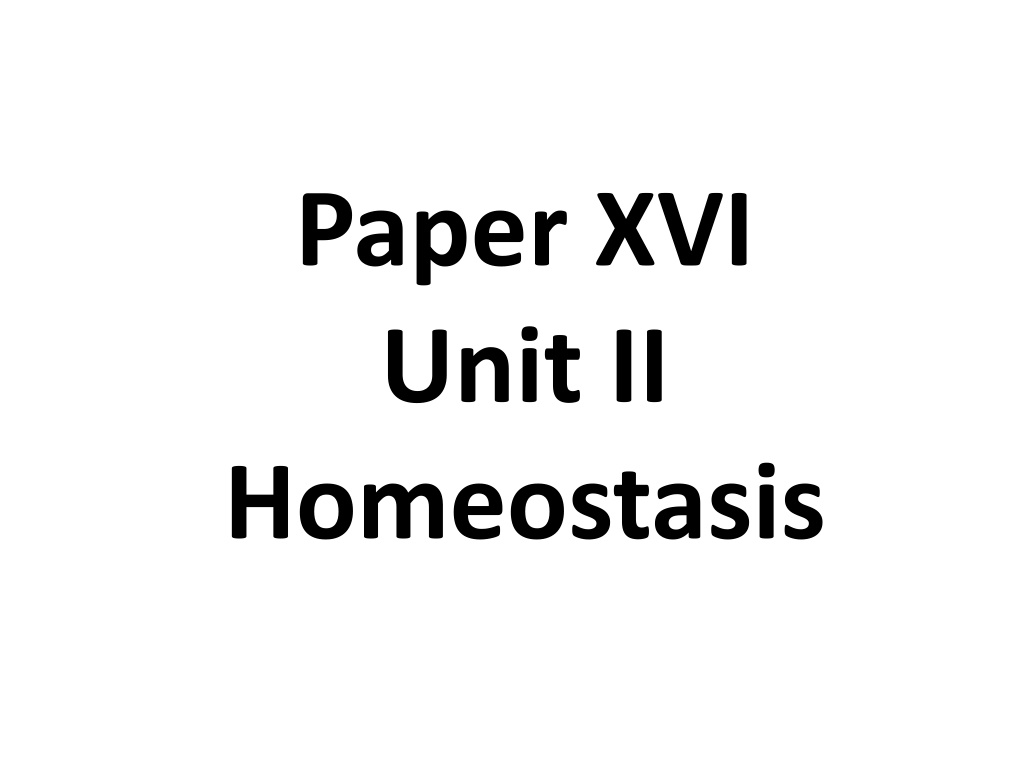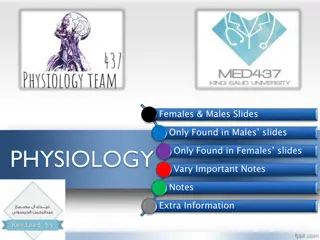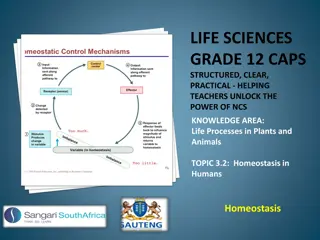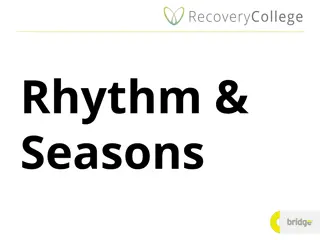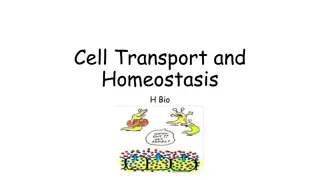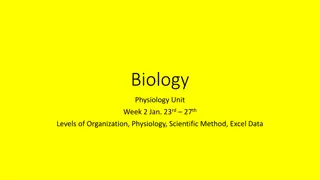Homeostasis and Circadian Rhythms
Homeostasis is the state of equilibrium maintained through internal control systems like receptors, control centers, and effectors. Feedback mechanisms, such as negative and positive feedback, help regulate processes like blood glucose levels and childbirth. Circadian rhythms, controlled by the body clock, govern biological activities cyclically over a 24-hour period. External factors like sunlight and temperature, known as Zeitgebers, influence circadian rhythms, with the suprachiasmatic nuclei in the hypothalamus playing a key role. The functioning of clock genes in the suprachiasmatic nuclei, along with the pineal gland's secretion of melatonin, helps orchestrate the body's internal timing mechanisms.
Download Presentation

Please find below an Image/Link to download the presentation.
The content on the website is provided AS IS for your information and personal use only. It may not be sold, licensed, or shared on other websites without obtaining consent from the author.If you encounter any issues during the download, it is possible that the publisher has removed the file from their server.
You are allowed to download the files provided on this website for personal or commercial use, subject to the condition that they are used lawfully. All files are the property of their respective owners.
The content on the website is provided AS IS for your information and personal use only. It may not be sold, licensed, or shared on other websites without obtaining consent from the author.
E N D
Presentation Transcript
Paper XVI Unit II Homeostasis
2.1. Homeostasis Homeostasis means state of equilibrium. The idea of homeostasis implies the existence of an internal control system. The control system comprises 1. Receptor 2. Control centre 3. Effector Any change in the set point conditions activates the control system and restores the conditions at optimum level. When the conditions are restored the corrective process is switched off. This is called feedback mechanism. There are two types of feedback mechanisms to maintain the homeostasis. 1. Negative feedback mechanism e.g. Control of blood glucose level 2. Positive feedback mechanism e.g. Normal child birth
Body Clock : Circadian and Diurnal rhythm Animals Exhibit certain behavior patterns that occur at regular interval of time. This rhythmic pattern of behavior is based on internal rythms and external cues or timers Intrinsic or endogemous physiological timing mechanisms are termed as Body Clock. Animal body clock are considered as organism s innate timing device, since they schedule different body functions and activities of particular times of day or season. Frenchman de Mairan in 1729 first demonstrated existence of body clock. Ex- plant leaves are raised or lowered in daily rhythm even when they are kept in constant darkness and at a constant temperature.
Circadian rhythm Circadian rhythms are patterns of biological activity that occur cyclically after a period of approximately 24hours. An endogenous rhythm that has a period about a day is termed as circadian rhythm. Examples: 1. Repetitive oscillations in body activities such as hormone levels and temperature. No sensory information is required for the initiation of such activities. They may drift or free run in constant light or darkness. A light regulates the circadian rhythm to exactly 24 hours. The study of circadian rhythm is called chronobiology.
Circadian rhythms are modulated by external factors called Zeitgebers (Time giver ), such as sunlight and temperature. Examples 1. Sleeping at night and being awake during the day. 2. Hormone release 3. Eating habits and digestion 4. Variations of body temperature Example of Principal Controlling Centre of circadian rhythm Location : In the paired uprachiasmatic nuclei (SCN) of the hypothalamic region of the diencephalon. Description: It is a group of nerve cells that receives direct input from the eyes and send out put to the pineal gland or other hypothalamic nuclei. Each SCN is situated just dorsal to the optic nerve at optic chiasma. Individual neurons of SCN are independently rhythmic and establish many of the inherent 24 hour rhythms of the mammals.
Functioning of the clock genes in the SCN is depend on the protein that they encode setting up feedback loops that have a 24 hour cycle and generate recurring cyclic activity. SCN works in conjunction with the pineal gland. Pineal gland is endocrine in function. It secretes hormone melatonin. Melatonin synchronizes the body s inherent circadian rhythms with the 24 hour day night cycle. Low level of melatonin is found during day time but it is higher during night (approx. tend folds).
Diurnal Rhythm Definition A circadian rhythm that is synchronized with the day and night cycle is called as diurnal rhythm (day-night). Diurnals rhythm means the organism is active during day time and sleeps at the night. It is an example of 24 hour cycle that is based up on the environmental factors. But diurnal rhythm may or may not be circadian rhythm. It is purely depend on the dynamic environmental factors.
Example of Diurnal Rhythm Secretion of hormones in humans shows diurnal rhythm. It is illustrated by secretion of stress hormone Cortisol. The levels of Cortisol hormone gradually increases during the night and reach peak level at early morning. This prepares the animal to face the stress of having to initiate daily activities, such as finding food immediately after waking . There after the cortisol levels gradually decreases during the day and are lowest in the evening.
2.2. Thermoregulation Thermoregulation is a process in which the body temperature of organisms is regulated for the efficient functioning of the body. The direct and indirect source of energy for all organisms is solar energy. It is converted into heat energy when it strikes and absorbed by body. All organisms need heat energy for survival. Temperature Is the important factor in the life of animal or organism. It determines the rate of biochemical reactions and consequently metabolic activity of animals.
2.2.1. Endothermy and Ectothermy Endothermy The animal which depend on internal sources of heat are termed as endothermic (Endos- Inside; therme- heat ). It is warming of the tissues by metabolic heat production. Birds and mammals are called thermoregulators because they maintain fairly constant temperature independent of the surrounding temperature by using physiological mechanisms. Birds and mammals are also called as homeothermic animals. In endothermy, the rate of energy release is regulated by surrounding temperature and hormones. The hormone thyroxine is increases the metabolic rate and consequently heat production for long term.
Examples of endothermic animals 1. Some Insects 2. Lower Vertebrates 3. Birds 4. Mammals Endotherms have following salient features 1. Regulation of body temperature by thermogenesis. 2. Maintain body temperature well above the ambient temperature in cold climate. 3. High rate of metabolic heat production. 4. Biochemical reactions are major source of heat. 5. Energy is released by breakdown of carbohydrates and fats. Advantages of Endothermy 1. Increased rate of enzymatic activity 2. A constant body temperature 3. Activities are largely independent of the environmental temperature.
Disadvantages of endothermy Energy cost of thermregualtion is very high. Example : Humans maintain their body temperature even when they are inactive. Ectothermy In many animals, the body temperature changes according to the fluctuations of environmental temperature. They can not regulate their body temperature by metabolism. But they gain heat from the environment . For example: invertebrates, fish and reptiles show some behavioral mechanisms. Such poikilothermic since they have variable body temperatures (Poikilo Variable ; therme- heat). animals are termed as They are dependent on the environment , energy source, t regulate the body temperature. Hence they are called ectothermic animals.
The ectothermic animals have following salient features 1. Passively adjust their body temperature with the ambient temperature. 2. They don t have physiological production. 3. They have high thermal conductance and poorly insulated. Hence heat derived from the metabolic process is quickly lost to the surroundings. 4. High conductance allows them ot absorb heat from the surrounding environment. 5. They regulate their body temperature by certain behavioral mechanisms. Advantages of Ectothermy 1. They have low rates of metabolic heat production. 2. More of heat for thermo-regulation comes from sun; therefore the energy expenditure is very low. 3. Most energy in their food can be utilized for growth and reproduction. mechanisms for heat
Disadvantages of Ectothermy Ectotherms are thermo-confirmers. They can live only in habitats with favourable temperature and their activity is limited by daily and seasonal temperature conditions. 2.2.2. Temperature Balance 1. It is connected with heat production, conservation, distribution, and heat loss from the body. 2. Animals have adapted and developed certain mechanisms to maintain the optimum temperature. It is essential for comfortable life and maximum physiological activities. 3. The thermal balance in animals occur as per the following equation Thermal Balance= Total amount of heat production Total amount of heat loss from the body
Temperature Balance Example: Hypothalamus in Mammals 1. Hypothalamus acts as an internal thermostat or control centre. 2. If there is any change in the set point conditions activates the control system and normal temperature is restored. 3. Hypothalamus has two distinct centers concerned with temperature balance namely, A. Heat Loss Centre B. Heat Gain Centre Both have antagonistic effect
It is situated in anterior hypothalamus Decrease in thickness of air layer by flattening the hair Increase in temperature activates hypothalamus Heat Loss Centre It increases sweating and panting. It increases vasodilation Thus it increases heat loss from the skin by radiation, convection and conduction
It is situated in posterior hypothalamus Decrease in thickness of air layer by flattening the hair Activated by nerve impulses from cold receptors present in the skin Heat Gain Centre It increases sweating and panting. Or it is also activated by decrease in temperature of the hypothalamus Thus it decreases heat loss from the skin by radiation, convection and conduction It increases Vasoconstriction
Metabolic activity is increased shivering and release of thyroxine and hormone through mechanism adrenaline There are various factors that responsible heat production like are for Increase thickness of the air layer by contraction of hair muscles makes the hair erect in the Shivering, Basal Rate Muscular exercise, Decrease in skin circulation, Diseases like fever higher Heat Gain Centre Metabolic (BMR), that Homeotherms Poikilotherms show different mechanisms temperature balance and of
Mechanism of heat production 1. Piloerection 2. Reduced blood flow to the skin 3. Sweat gland activity decreases or stops 4. Panting also ceases. 5. Increased muscular acivity 6. Non shivering thermogenesis includes calorigenic action of hormones and oxidation of brown fat 7. Behavioral reponses so as to reduce heat loss or combat cold conditions Examples : migration to warm places, huddling to keep warm, hibernation among birds and mammals to survive harsh winter
Shivering Thermogenesis I. Heat is a by -product intracellular metabolism in muscle cells. II. Energy is released in the form of ATP. III. Shivering is involuntary, high frequency uncontrolled skeletal muscle contraction to liberate heat IV. IN the shivering, contractions of skeletal muscles occur at the rate of 10-20 contractions per second V. Heat is produced during the shivering
Non Shivering Thermogenesis I. Hear production mechanisms other that shivering mechanism are called as non shivering thermogenesis. II. It is an extracellular source of heat production. Example : In mammals, this kind of thermogenesis occurs in resting and fasting state. Brown Fat area is one of the best site of non shivering thermogenesis.
Brown Fat (Brown Adipose Tissue BAT) 1. It is called the hibernating gland. 2. It is special thermigenic tissue in mammals. 3. It is present in neck and thoracic region near the major blood vessles. 4. It is an important site for non shivering thermogenesis. 5. Brown fat is stimulated by nor adrenaline to produce heat. It results into the activation of adenylcyclase system by sympathetic nervous system. 6. Release of catecholeamine activates the adenylcyclase system and cyclic AMP promotes a rapid lipolysis within the cell. 7. The onset of rapid lipolysis and ixidation of fat results in heat production.
Histological Structure of Brown Fat I. It is highly vascular tissue. II. It has high concentrations of myoglobin, cytochromes and flavin compounds. III. It is pale buff coloured or reddish brown coloured. IV. It is rich in mitochondria. V. It is brown colour appears due to the large number of mitochondria with their iorn porphyrin containing cytochrome compounds. VI. Thermogenin is present in the inner membrane of mitochondria. VII. Thermogenin is membrane protein
Structure of Brown Fat VIII.The function of thermogenin is to uncouple the ATP during oxidative phosphorylation and heat is generated instead of ATP IX. Cells of brown fat are small, polygonal, central nucleus X. Cells also contain numerous, small mitochondria associated with fat droplets. XI. Biochemically brown fat shows high concentrations of water, protein, phospholipids, cholesterol and certain mitochondrial enzymes. Hence it has much high respiration.
Mechanism of Heat Loss 1. Conduction Transfer of heat by physical contact between two objects. 2. Convection : Heat is transferred between the organisms and environment in air or water that is in contact with the surface of an organism. 3. Radiation It is the dominant mehanism of heat transfer with the environment for terrestrial animals. It involves heat exchange through infra-red radiations. All organisms emit electromagneti cradiations . Hence all organisms are sources of electromagnetic radiations.
Excess heat in the body is removed with the help of 1. Hair erector muscles 2. Vasodilation 3. Enhanced evaporation 4. Lowered BMR 5. Use of Behavioral mechanisms
2.2.2. Adaptive Response to Temperature 1. Daily torpor It is temporary or short term hibernation. It is commonly seen in small sized animals. It is a form of adaptive hypothermia. In this, there is decline in core body temperature. 2. Hibernation It is the phenomenon where the animal goes under seasonal dormancy to escape from excessive cold. 3. Aestivation- It is state of dormancy exhibited by animals especially in summer to escape the surrounding scorching heat of sun.
2.3. Osmotic and ionic regulation Hypo-osmotic Environment Example : Freshwater body. In Freshwater habitat, the osmotic pressure is low due to the presence of ions in very dilute form as compared to concentration in sea water. Adaptations that are seen in Freshwater Animals 1. Contractile vacuole present. 2. Production of very dilute urine. 3. Presence of protective and impermiable covering on body surface. 4. Ability to obtain salts through diet.
Hyperosmotic Environment Example : Marine environment has very high osmotic pressure. Salts contents are very high. The animals in the marine environment are hypoosmotic to their surrounding environment . Hence, they tend to lose water by osmosis and conserve the salts by diffusion. Physiological Adaptations seen in Marine animals 1. Presence of covering on body surface. 2. Drinking the medium. 3. Morphological changes in renal system. 4. Retension of salts in the body. 5. Presence of isotonic body fluids.
Living in Terrestrial Environment It represents the land portionn and shows high ecological niches. It lacks water an d salts in the surrounding medium. The terrestrial environment is of two types namely, 1. Humidic Terrestrial Environment It represents the moist/ humid, water rich micro environments. 1. Xeric Terrestrial Environment It represents the dry, water poor places. Physiological adaptations in terrestrial animals Reduction of the permiability of the skin. Presence of marked talerance of destruction Absorption of water by rectum and cloaca. Absence of sweat glands. Reabsorption of water from the urine. Use of metabolic water.
Water absorption Water absorption is the ability by which animal take up large amount of water rapidly from the surroundings. This ability is seen many animals Exmaple : Desert Frogs Arachnids, Milipedes and in insects. Water absorption is associated with the capacity of tissue dehydration, absence of moist foods and limited source of drinking water. Water absortption is carried through various routes such as skin, most body surface, rectum and through hydrophilic cuticle.
Salt water ingestion and excretion It is the process of maintenance of salt water balance in the body. It depends on the environment. These animals show physiological and morphological adaptations. These includes development of orbital glands, nasal or salt glands as well as rectal glands in addition to the kidney. In animals, the extra load of their body salts incurred due to salt water ingestion is handled by 1. Presence of ionic regulation surface. 2. Presence of salt glands. 3. Production of hyperosmotic urine 4. Development of special glands 5. Excretion of excess cations as urate salts.
Metabolic Water The water produced by the metabolic reactions within the body is called as metabolic water or endogenous water . This water is derived from the oxidation of energy containing food stuffs hence also called as oxidation water. The metabolic water is produced by oxidation of glucose molecules. C6H12O6 + 6O2 The water production through an catabolism of food stuffs obligates certain amount of water ions from the body. Therefore the newt amount of water produces is not become available to the animal. There are three types oblogatory water loss viz. Obligatory respiratory water loss, Obligatory Urinary water loss and Obligatory faecal water loss. 6CO2 + 6H2O
Salt Glands These are the paired, crescent shaped organs of extra renal salt excretion located in the head above the eyes. These glands excrete hyperosmotic NACl or KCL. Salts gands are provided with ducts that carry the secretions of the salt glands to the nostrils. Reptilian salt glands have diverse origin and less specialized structure. They are single lobed shows more general ions excretion capabilities and secrete NA+ , K + Cl - and HCO3 In T.S. salt glands shows many longitudinal lobes approximaely 1 mm. in diameter. Each lobe is branched, radially arranged, secretary canals and central canal. Example: Reptiles and Birds, terrestrial animals and marine animals also.
2.3.2. Role of Kidney in Ionic Regulation Kidney acts as organ of osmoregulation. Kidneys work on the principal of ultrafiltration of plasma, reabsorption of some substances and water and tubular secretion. The excretory and functional unit of the kidney is Nephron The loop of Henle is unique feature of mammalian kidney. The loop of henle has tw o limbs viz. descending limb and ascending limb. Loop of Henle shows differential permiability of water and salts at various levels. The entire length of nephrons is permeable to water except the descending limb of the loop of Henle. The regulation of the urine is shown in the following figure.
